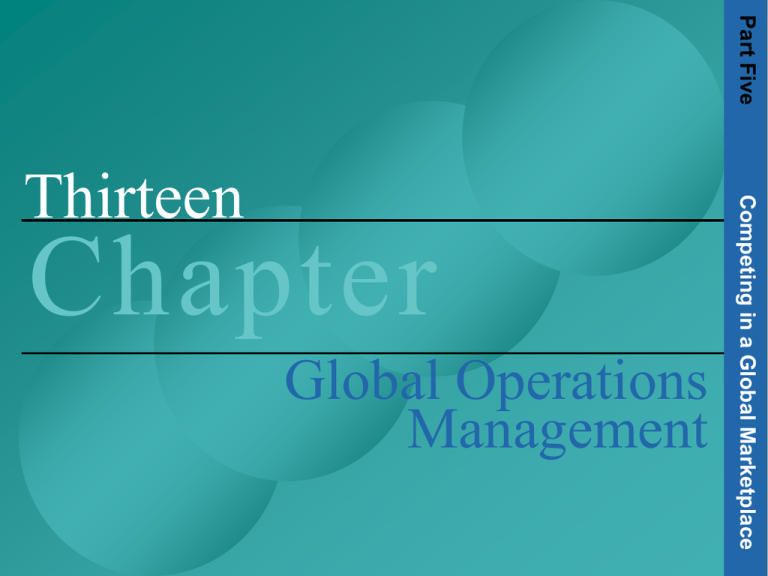
Part Five
Chapter
Global Operations
Management
Competing in a Global Marketplace
Thirteen
Slide
13-1
Manufacturing and Materials Management
Production:
activities that involve
Service and manufacturing
converting inputs to a product
Materials
management: activities that
Control the transmission of physical materials through the
value chain:
procurement –> production –> distribution
Logistics
Procurement and physical transmission of material
through the supply chain
suppliers –> customers
Irwin/McGraw-Hill
Copyright 2001 The McGraw-Hill Companies, Inc. All rights reserved.
Slide
13-2
Quality and Costs
Quality …
Increases
Productivity
Improves
Performance
Reliability
Lowers
Rework and
Scrap Costs
Lowers
Warranty
Costs
Lowers
Manufacturing
Costs
Lowers
Service
Costs
Increases
Profits
Fig. 13.1
Irwin/McGraw-Hill
Copyright 2001 The McGraw-Hill Companies, Inc. All rights reserved.
Slide
13-3
ISO 9000
European
Set
Unions standards for quality
by code
Firm
must be certified “ISO 9000” before it is
allowed access to the EU marketplace
Irwin/McGraw-Hill
Copyright 2001 The McGraw-Hill Companies, Inc. All rights reserved.
Slide
13-4
Manufacturing Location Decision
Country
Factors
Favorable economic, political, cultural conditions
Technological
Factors
Fixed costs relatively low
Minimum efficient scale
Scale
of output a plant needs to realize scale-economies
Market demand must be sufficient to reach this scale
Flexible manufacturing-lean production-mass customization
Product
features
Value-to-weight ratio
Universal needs
Irwin/McGraw-Hill
Copyright 2001 The McGraw-Hill Companies, Inc. All rights reserved.
Slide
13-5
Where to Locate?
Concentrate
manufacturing if:
Costs of manufacturing are responsive to country
environment (one location best)
Trade barriers are low
Exchange rates among currencies with impact on your
business are stable
Production technology
Has
high fixed costs
Has high minimum efficient scale
Exists in flexible manufacturing format
Product value-to-weight ratio is high
Product serves universal needs – minor difference in
customer needs, consumer preferences
Irwin/McGraw-Hill
Copyright 2001 The McGraw-Hill Companies, Inc. All rights reserved.
Slide
13-6
Where to Locate?
Decentralize
manufacturing if:
Country environment does not affect costs much
Trade barriers are high
Production technology
Has
low fixed costs
Has low minimum efficient scale
Does not exists in flexible manufacturing format
Product value-to-weight ratio is low
Product does not serve universal needs – significant
difference in customer needs, consumer preferences
Irwin/McGraw-Hill
Copyright 2001 The McGraw-Hill Companies, Inc. All rights reserved.
Slide
13-7
Make-or-Buy?
“Make”
advantage
Lower costs in-house?
Are specialized assets needed?
Investment
issue
Is proprietary technology needed?
Know-how
“Buy”
protection issue (Dunning)
advantage
Strategic flexibility needed?
Lower costs by buying?
Offsets a possibility by?
In
either case “improved scheduling” just as important
Irwin/McGraw-Hill
Copyright 2001 The McGraw-Hill Companies, Inc. All rights reserved.
Slide
13-8
Other Issues
Strategic
alliances with suppliers
Just-in-time
The
inventory system management
role of information technology
Irwin/McGraw-Hill
Copyright 2001 The McGraw-Hill Companies, Inc. All rights reserved.





